Microstructure Optimization and Coercivity Enhancement of Sintered NdFeB Magnet by Grain Boundary Diffusion of Multicomponent Tb60Pr10Cu10Al10Zn10 Films
Abstract
:1. Introduction
2. Materials and Methods
3. Results and Discussion
4. Conclusions
Author Contributions
Funding
Institutional Review Board Statement
Informed Consent Statement
Data Availability Statement
Conflicts of Interest
References
- Hirosawa, S.; Matsuura, Y.; Yamamoto, H.; Fujimura, S.; Sagawa, M. Magnetization and magnetic anisotropy of R2Fe14B measured on single crystals. J. Appl. Phys. 1986, 59, 873–879. [Google Scholar] [CrossRef]
- Bai, G.; Gao, R.W.; Sun, Y.; Han, G.B.; Wang, B. Study of high-coercivity sintered NdFeB magnets. J. Magn. Magn. Mater. 2007, 308, 20–23. [Google Scholar] [CrossRef]
- Gutfleisch, O.; Willard, M.A.; Brück, E.; Chen, C.H.; Sankar, S.G.; Liu, J.P. Magnetic materials and devices for the 21st century: Stronger, lighter, and more energy efficient. Adv. Mater. 2011, 23, 821–842. [Google Scholar] [PubMed]
- Sun, R.; Zheng, J.; Zheng, B.; Qian, N.; Li, J.; Deng, Z. New magnetic rails with double-layer Halbach structure by employing NdFeB and ferrite magnets for HTS maglev. J. Magn. Magn. Mater. 2018, 445, 44–48. [Google Scholar] [CrossRef]
- Matsuura, Y. Recent development of Nd-Fe-B sintered magnets and their applications. J. Magn. Magn. Mater. 2006, 303, 344–347. [Google Scholar] [CrossRef]
- Hono, K.; Sepehri-Amin, H. Strategy for high-coercivity Nd-Fe-B magnets. Scr. Mater. 2012, 67, 530–535. [Google Scholar] [CrossRef]
- Sepehri-Amin, H.; Ohkubo, T.; Hono, K. The mechanism of coercivity enhancement by the grain boundary diffusion process of Nd-Fe-B sintered magnets. Acta. Mater. 2013, 61, 1982–1990. [Google Scholar] [CrossRef]
- Hu, Z.H.; Lian, F.Z.; Zhu, M.G.; Li, W. Effect of Tb on the intrinsic coercivity and impact toughness of sintered Nd-Dy-Fe-B magnets. J. Magn. Magn. Mater. 2008, 320, 1735–1738. [Google Scholar] [CrossRef]
- Herbst, J.F. R2Fe14B materials: Intrinsic properties and technological aspects. Rev. Mod. Phys. 1991, 63, 819. [Google Scholar]
- Kim, T.H.; Lee, S.R.; Kim, H.J.; Lee, M.W.; Jang, T.S. Simultaneous application of Dy-X (X= F or H) powder doping and dip-coating processes to Nd-Fe-B sintered magnets. Acta. Mater. 2015, 93, 95–104. [Google Scholar] [CrossRef]
- Cao, X.; Chen, L.; Guo, S.; Chen, R.; Yan, G.; Yan, A. Impact of TbF3 diffusion on coercivity and microstructure in sintered Nd-Fe-B magnets by electrophoretic deposition. Scr. Mater. 2016, 116, 40–43. [Google Scholar]
- Li, W.; Yang, L.; Zhang, Q.; Xu, C.; Zhu, Q.; Song, Z.; Zheng, B.; Fang, H.; Jiang, J. Effect of the grain boundary Tb/Dy diffused microstructure on the magnetic properties of sintered Nd-Fe-B magnets. J. Magn. Magn. Mater. 2020, 502, 166491. [Google Scholar]
- Bance, S.; Fischbacher, J.; Schrefl, T. Thermally activated coercivity in core-shell permanent magnets. J. Appl. Phys. 2015, 117, 17A733. [Google Scholar]
- Huang, M.; Qiu, Z.; Wang, F.; Luo, H.; Zhang, J. High-efficiency utilization of Tb in enhancing the coercivity of Nd-Fe-B magnets by multicomponent Tb70-xPrxCu10Al10Zn10 (x= 0–30) film diffusion. J. Alloy. Comp. 2022, 901, 163619. [Google Scholar]
- Jin, L.; Ding, G.; Zhu, J.; Jin, Z.; Zheng, B.; Guo, S.; Chen, R.; Yan, A.; Liu, X. Effective microstructure optimization and coercivity enhancement of sintered Nd–Fe–B magnet by grain boundary diffusion of Pr60Tb13Al27 alloy. J. Alloy. Comp. 2021, 870, 159375. [Google Scholar]
- Chen, G.; Bao, X.; Lu, K.; Lv, X.; Ding, Y.; Zhang, M.; Wang, C.; Gao, X. Microstructure and magnetic properties of Nd-Fe-B sintered magnet by diffusing Pr-Cu-Al and Pr-Tb-Cu-Al alloys. J. Magn. Magn. Mater. 2019, 477, 17–21. [Google Scholar]
- Zhou, T.; Guo, Y.; Xie, G.; Rehman, S.U.; Liu, R.; Liu, J.; Qu, P.; Li, M. Coercivity and thermal stability enhancement of NdFeB magnet by grain boundary diffusion Tb80Al20 alloys. Intermetallics 2021, 138, 107335. [Google Scholar]
- Li, J.; Guo, C.; Zhou, T.; Qi, Z.; Yu, X.; Yang, B.; Zhu, M. Effects of diffusing DyZn film on magnetic properties and thermal stability of sintered NdFeB magnets. J. Magn. Magn. Mater. 2018, 454, 215–220. [Google Scholar] [CrossRef]
- Zhong, S.; Munan, Y.; Rehman, S.U.; Yaojun, L.; Jiajie, L.; Yang, B. Microstructure, magnetic properties and diffusion mechanism of DyMg co-deposited sintered Nd-Fe-B magnets. J. Alloy. Comp. 2020, 819, 153002. [Google Scholar]
- Jin, L.; Jin, Z.H.; Zhu, J.H.; Ding, G.F.; Zheng, B.; Guo, S.; Chen, R.J.; Yan, A.R.; Liu, X.C. Coercivity and microstructure of sintered Nd-Fe-B magnets diffused with Pr-Co, Pr-Al, and Pr-Co-Al alloys. Chin. Phys. B. 2021, 30, 027503. [Google Scholar]
- Li, J.; Huang, X.; Zeng, L.; Ouyang, B.; Yu, X.; Yang, M.; Yang, B.; Rawat, R.S.; Zhong, Z. Tuning magnetic properties, thermal stability and microstructure of NdFeB magnets with diffusing Pr-Zn films. J. Mater. Sci. Technol. 2020, 41, 81–87. [Google Scholar] [CrossRef]
- Tang, M.; Bao, X.; Lu, K.; Sun, L.; Li, J.; Gao, X. Boundary structure modification and magnetic properties enhancement of Nd-Fe-B sintered magnets by diffusing (PrDy)-Cu alloy. Scr. Mater. 2016, 117, 60–63. [Google Scholar] [CrossRef]
- Bae, K.H.; Lee, S.R.; Kim, H.J.; Lee, M.W.; Jang, T.S. Effect of oxygen content of Nd-Fe-B sintered magnet on grain boundary diffusion process of DyH2 dip-coating. J. Appl. Phys. 2015, 118, 203902. [Google Scholar] [CrossRef]
- Oono, N.; Sagawa, M.; Kasada, R.; Matsui, H.; Kimura, A. Production of thick high-performance sintered neodymium magnets by grain boundary diffusion treatment with dysprosium-nickel-aluminum alloy. J. Magn. Magn. Mater. 2011, 323, 297–300. [Google Scholar] [CrossRef]
- Kim, T.H.; Lee, S.R.; Yun, S.J.; Lim, S.H.; Kim, H.J.; Lee, M.W.; Jang, T.S. Anisotropic diffusion mechanism in grain boundary diffusion processed Nd-Fe-B sintered magnet. Acta. Mater. 2016, 112, 59–66. [Google Scholar] [CrossRef]
- Hu, S.Q.; Peng, K.; Chen, H. Influence of annealing temperature on the Dy diffusion process in NdFeB magnets. J. Magn. Magn. Mater. 2017, 426, 340–346. [Google Scholar] [CrossRef]
- Wang, C.G.; Yue, M.; Zhang, D.T.; Liu, W.Q.; Zhang, J.X. Structure and magnetic properties of hot deformed Nd2Fe14B magnets doped with DyHx nanoparticles. J. Magn. Magn. Mater. 2016, 404, 64–67. [Google Scholar] [CrossRef]
- Pope, C.G. X-ray diffraction and the Bragg equation. J. Chem. Educ. 1997, 74, 129. [Google Scholar] [CrossRef]
- Yang, M.; Wang, H.; Hu, Y.; Yang, L.; Maclennan, A.; Yang, B. Increased coercivity for Nd-Fe-B melt spun ribbons with 20 at. % Ce addition: The role of compositional fluctuation and Ce valence state. J. Alloy. Comp. 2017, 710, 519–527. [Google Scholar] [CrossRef]
- Minakshi, M. FePO4 cathode in aqueous solutions. Electrochimica. Acta 2010, 55, 9174–9178. [Google Scholar] [CrossRef]
- Minakshi, M.; Nallathamby, K.; Mitchell, D.R. Electrochemical characterization of an aqueous lithium rechargeable battery: The effect of CeO2 additions to the MnO2 cathode. J. Alloy Comp. 2009, 479, 87–90. [Google Scholar] [CrossRef]
- Li, W.; Zhang, Q.; Zhu, Q.; Xiao, S.; Xu, C.; Yang, L.; Zheng, B.; Mao, S.; Song, Z. Formation of anti-shell/core structure of heavy rare earth elements (Tb, Dy) in sintered Nd-Fe-B magnet after grain boundary diffusion process. Scr. Mater. 2019, 163, 40–43. [Google Scholar] [CrossRef]
- Di, J.; Ding, G.; Tang, X.; Yang, X.; Guo, S.; Chen, R.; Yan, A. Highly efficient Tb-utilization in sintered Nd-Fe-B magnets by Al aided TbH2 grain boundary diffusion. Scr. Mater. 2018, 155, 50–53. [Google Scholar] [CrossRef]
- Mehrer, H. Diffusion in solids: Fundamentals, methods, materials, diffusion-controlled processes. Clc 2007. [Google Scholar]
- Sasaki, T.T.; Ohkubo, T.; Takada, Y.; Sato, T.; Kato, A.; Kaneko, Y.; Hono, K. Formation of non-ferromagnetic grain boundary phase in a Ga-doped Nd-rich Nd-Fe-B sintered magnet. Scr. Mater. 2016, 113, 218–221. [Google Scholar] [CrossRef]
- Zhu, J.H.; Jin, L.; Jin, Z.H.; Ding, G.F.; Zheng, B.; Guo, S.; Chen, R.J.; Yan, A.R. Effects of post-sinter annealing on microstructure and magnetic properties of Nd-Fe-B sintered magnets with Nd-Ga intergranular addition. Chin. Phys. B. 2021, 30, 067503. [Google Scholar] [CrossRef]
- Peng, H.; Yu, D.; Bai, X.; Lin, X.; Mao, Y.; Wang, Z.; Luo, Y. Effects of grain boundary diffusion of PrCu alloy on microstructure and coercivity of hot deformed (Nd, Ce)-Fe-B magnets. J. Rare Earth. 2021, 39, 986–992. [Google Scholar] [CrossRef]

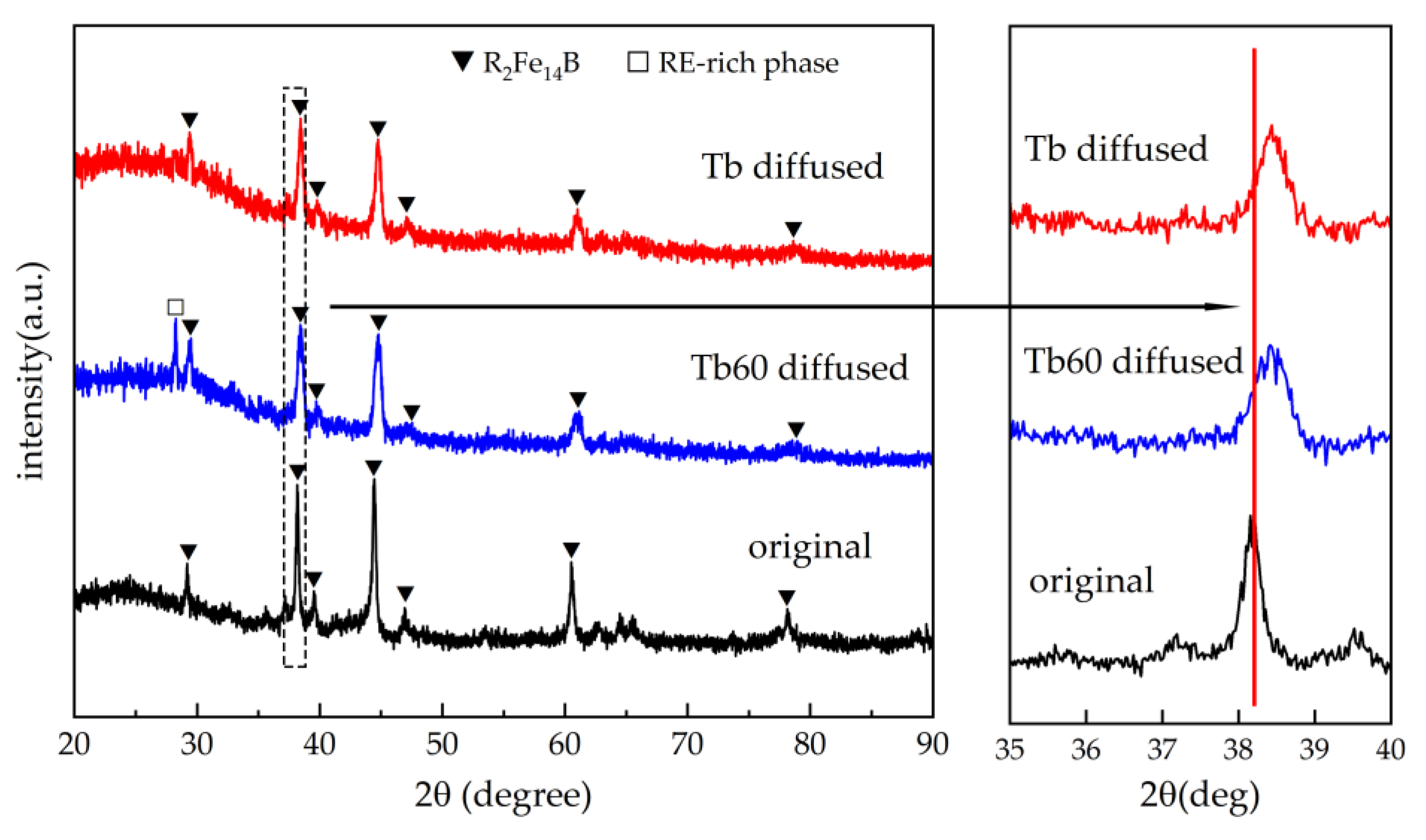
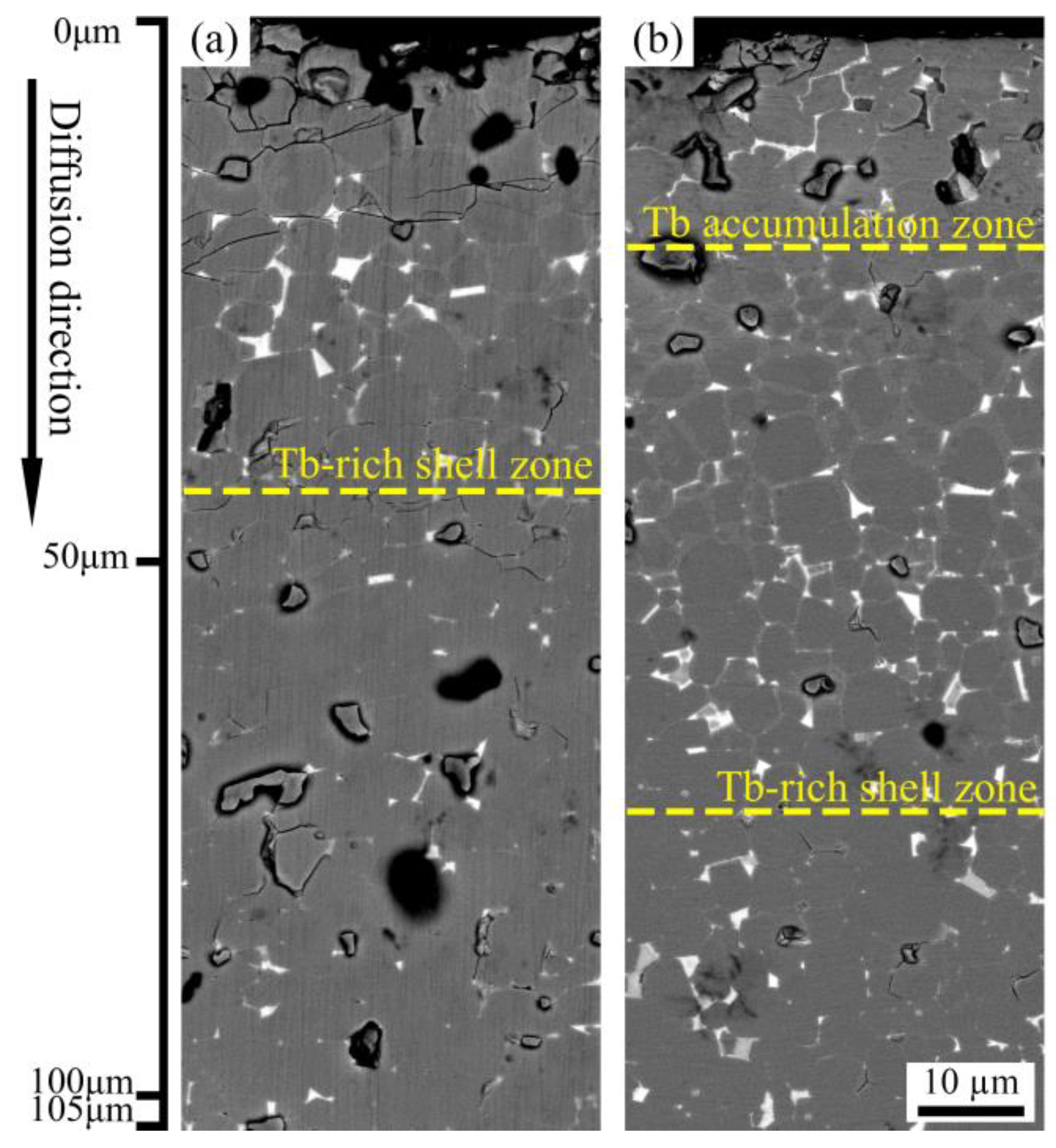
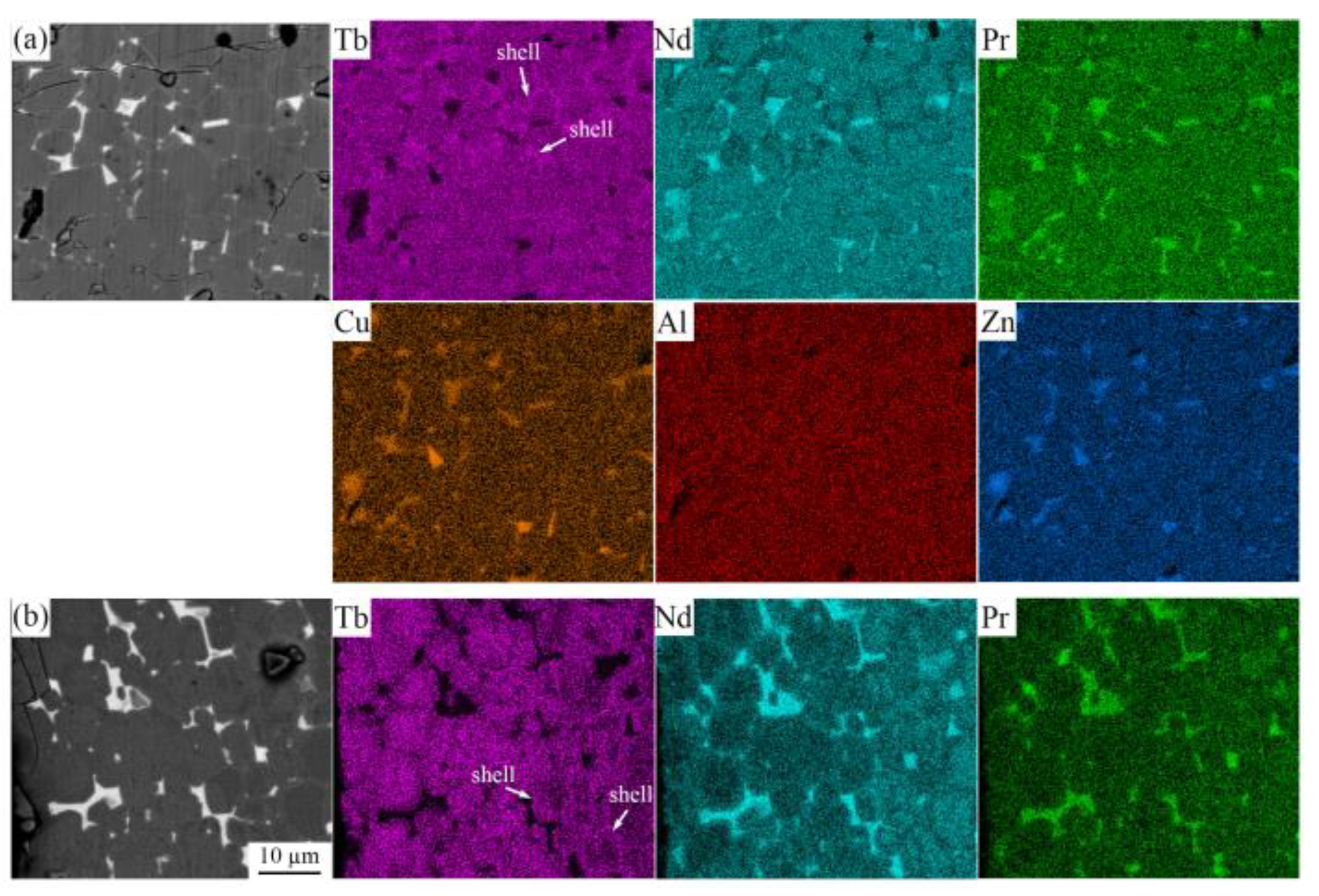
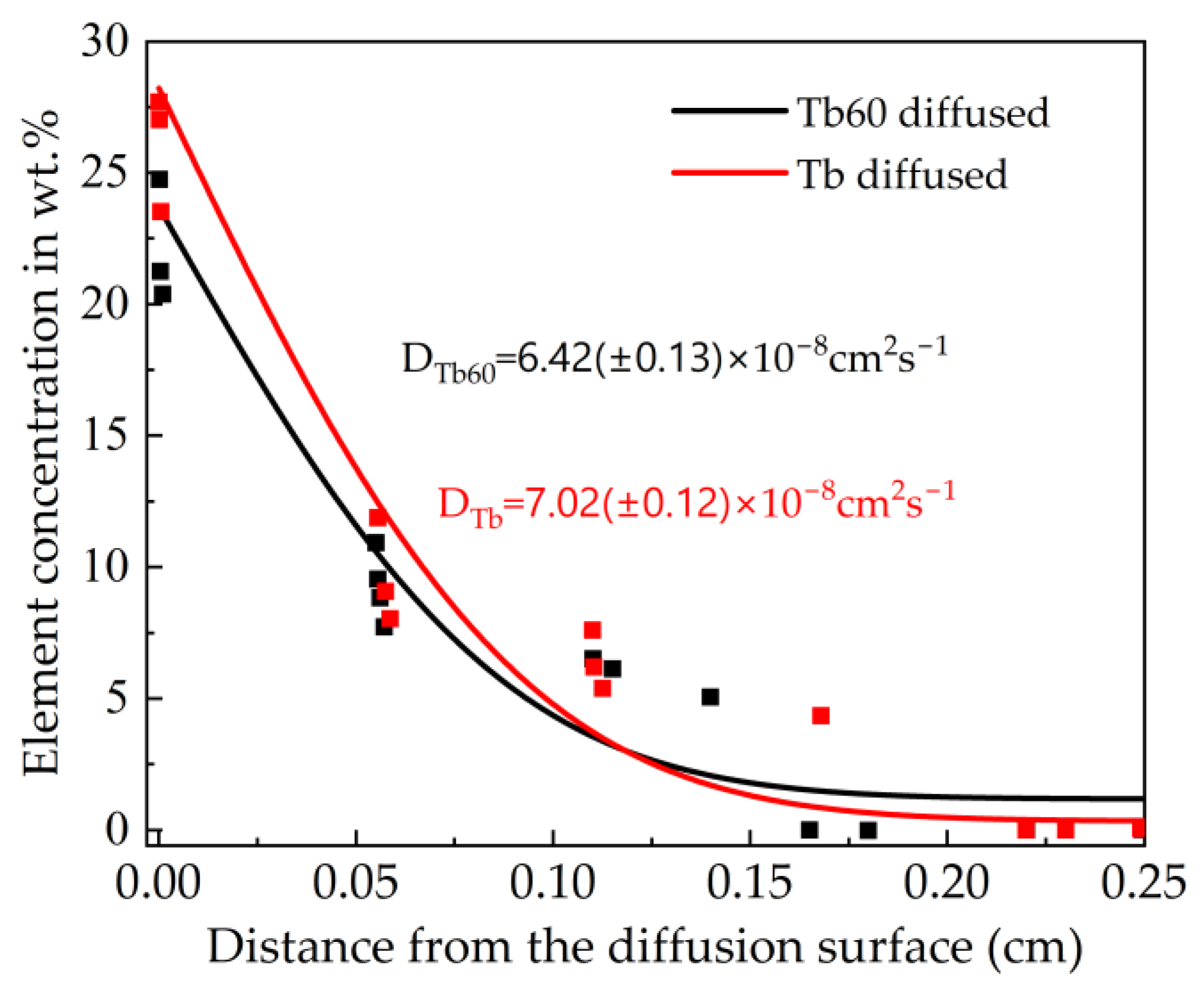

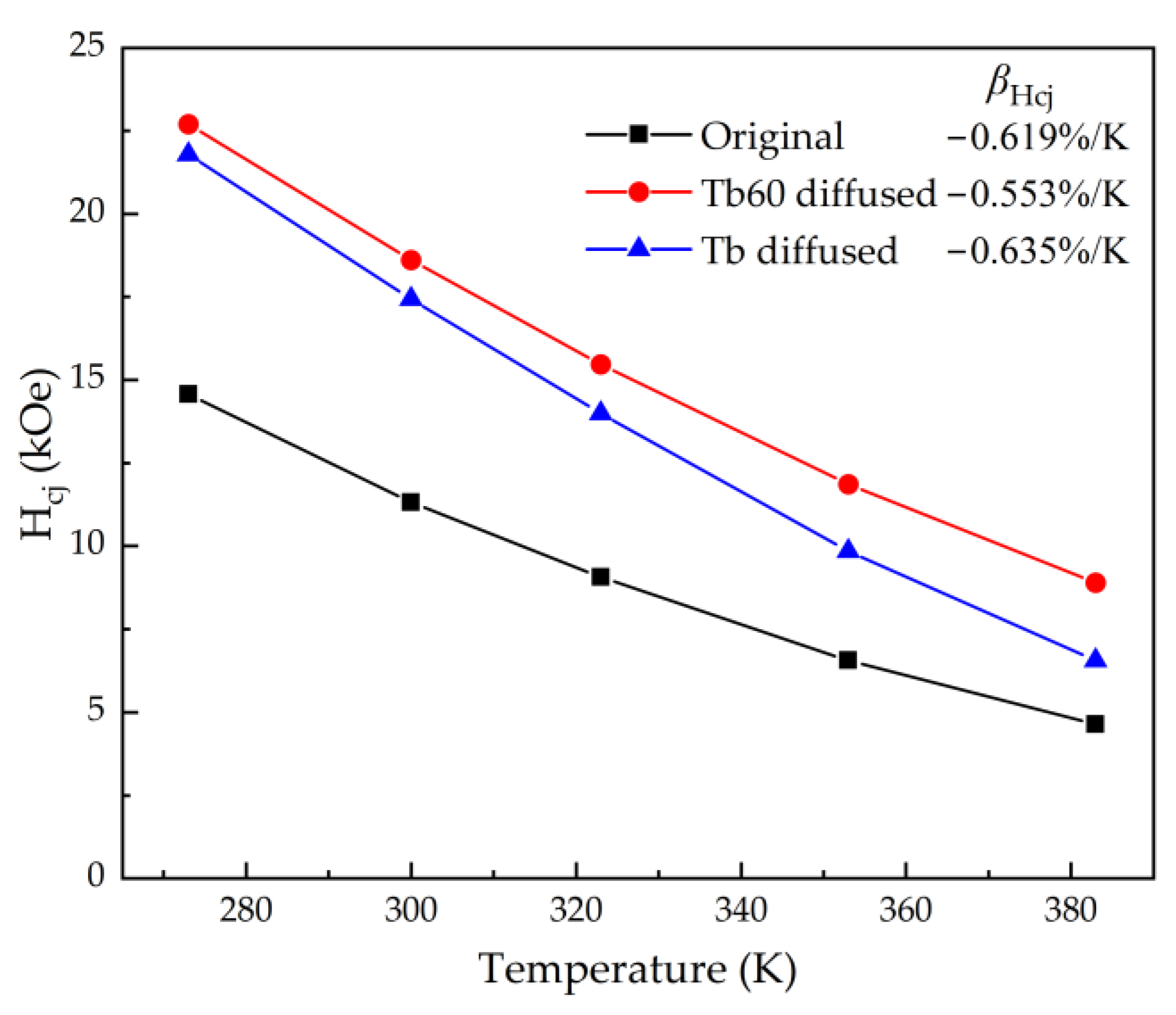
| Magnet | Hcj (kOe) | Mr (kGs) | (BH)max (kJ m−3) |
|---|---|---|---|
| Original | 11.54 | 13.74 | 338.94 |
| Tb60 | 18.89 | 14.39 | 378.26 |
| Tb | 17.80 | 13.50 | 316.49 |
Disclaimer/Publisher’s Note: The statements, opinions and data contained in all publications are solely those of the individual author(s) and contributor(s) and not of MDPI and/or the editor(s). MDPI and/or the editor(s) disclaim responsibility for any injury to people or property resulting from any ideas, methods, instructions or products referred to in the content. |
© 2023 by the authors. Licensee MDPI, Basel, Switzerland. This article is an open access article distributed under the terms and conditions of the Creative Commons Attribution (CC BY) license (https://creativecommons.org/licenses/by/4.0/).
Share and Cite
Huang, J.; Huang, M.; Wang, F.; Wang, Z.; Zhang, J. Microstructure Optimization and Coercivity Enhancement of Sintered NdFeB Magnet by Grain Boundary Diffusion of Multicomponent Tb60Pr10Cu10Al10Zn10 Films. Materials 2023, 16, 3131. https://doi.org/10.3390/ma16083131
Huang J, Huang M, Wang F, Wang Z, Zhang J. Microstructure Optimization and Coercivity Enhancement of Sintered NdFeB Magnet by Grain Boundary Diffusion of Multicomponent Tb60Pr10Cu10Al10Zn10 Films. Materials. 2023; 16(8):3131. https://doi.org/10.3390/ma16083131
Chicago/Turabian StyleHuang, Jingbin, Min Huang, Fang Wang, Zhanyong Wang, and Jian Zhang. 2023. "Microstructure Optimization and Coercivity Enhancement of Sintered NdFeB Magnet by Grain Boundary Diffusion of Multicomponent Tb60Pr10Cu10Al10Zn10 Films" Materials 16, no. 8: 3131. https://doi.org/10.3390/ma16083131




